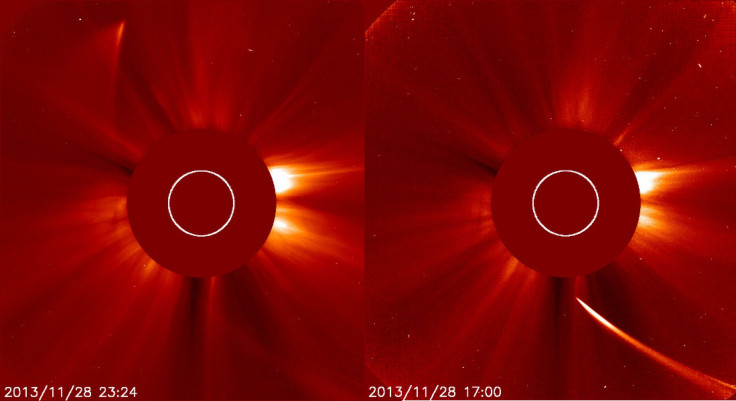Comet ISON Autopsy: NASA Details Last Days Of The ‘Comet Of Century,’ Fatal Encounter With The Sun

Comet ISON did not end up being the “comet of the century” as many hoped but scientists are still excited about the comet even after its demise. NASA presented the last days of ISON and discussed the final moment of the comet’s existence and what the event means for the scientific community.
NASA presented its findings at the 2013 Fall American Geophysical Union meeting, held in San Francisco, Calif., on Dec. 10. ISON’s orbit would bring the comet dangerously close to the sun, just 730,000 miles from the surface of the star, and there was always the risk that the comet would not survive the trip. If ISON would have survived the trip it would have been visible with the naked eye during the day on Earth.
C/2012 S1 was first discovered by two Russian astronomers, Vitali Nevski and Artyom Novichonok, in 2012 when ISON was 585 million miles from Earth. Unlike other comets that have returning orbits, such as Halley’s Comet, the trip around the sun was ISON’s first and, ultimately, its last. While ISON is a recent discovery its origins dates back billions of years within the Oort cloud, approximately 4.5 trillion miles from the sun, reports NASA. Something happened which caused ISON to be kicked out of the cloud and begin its life as a comet.
Before ISON reached the closest point to the sun, known as the perihelion, the comet began to lose mass and broke up as it made its closest pass around the sun. Despite the loss, ISON will have a lasting legacy as it was well-documented comet, with observatories and amateur astronomers carefully monitoring ISON’s journey.
Karl Battams, an astrophysicist at the Naval Research Lab in Washington, D.C., said in a statement, “The dirty snowball that we came to call Comet ISON was created at the same time as the planets.”
With all eyes on ISON, astronomers were able to gain new insights on how the sun affects comets. With many observatories tuned in to ISON’s approach to the sun, NASA’s Solar Dynamics Observatory was unable to image the comet. The reason for this may have been due to the lack of oxygen emitted by the comet. Dean Pesnell, project scientist for NASA’s SDO, said, “The fact that ISON did not show oxygen despite how close it came to the sun provides information about how high was the evaporation temperature of ISON's material.” NASA says they have years of data to cull through and could give researchers new insight into the early universe as well as the composition of comets.
© Copyright IBTimes 2025. All rights reserved.






















